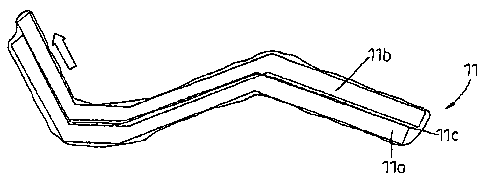Une partie des informations de ce site Web a été fournie par des sources externes. Le gouvernement du Canada n'assume aucune responsabilité concernant la précision, l'actualité ou la fiabilité des informations fournies par les sources externes. Les utilisateurs qui désirent employer cette information devraient consulter directement la source des informations. Le contenu fourni par les sources externes n'est pas assujetti aux exigences sur les langues officielles, la protection des renseignements personnels et l'accessibilité.
L'apparition de différences dans le texte et l'image des Revendications et de l'Abrégé dépend du moment auquel le document est publié. Les textes des Revendications et de l'Abrégé sont affichés :
| (12) Brevet: | (11) CA 2488147 |
|---|---|
| (54) Titre français: | MATELAS REDUCTEUR DE PRESSION |
| (54) Titre anglais: | A PRESSURE RELIEVING MATTRESS |
| Statut: | Accordé et délivré |
| (51) Classification internationale des brevets (CIB): |
|
|---|---|
| (72) Inventeurs : |
|
| (73) Titulaires : |
|
| (71) Demandeurs : |
|
| (74) Agent: | OSLER, HOSKIN & HARCOURT LLP |
| (74) Co-agent: | |
| (45) Délivré: | 2012-02-28 |
| (22) Date de dépôt: | 2004-11-22 |
| (41) Mise à la disponibilité du public: | 2006-05-22 |
| Requête d'examen: | 2009-08-13 |
| Licence disponible: | S.O. |
| Cédé au domaine public: | S.O. |
| (25) Langue des documents déposés: | Anglais |
| Traité de coopération en matière de brevets (PCT): | Non |
|---|
| (30) Données de priorité de la demande: | S.O. |
|---|
Cette invention se rapporte à un matelas, comme un matelas à pression. Ce type de matelas comprend une partie de base (11a) et une partie supérieure (11b) recouvrant la partie de base et comportant un élément de jonction (11c) intercalaire dont le coefficient de frottement est suffisamment faible pour que les parties susmentionnées puissent glisser l'une par rapport à l'autre. Ce processus permet le mouvement relatif des parties, lorsque le matelas repose sur un lit à profilage et que le lit est profilé.
This invention relates to mattresses, such as pressure mattresses comprising a base portion 11a and an upper portion 11b overlying the base portion and having an interface 11 c between the portions which has a coefficient of friction low enough such that the portions can slide relative to each other. This enables relative movement of the portions, when the mattress is lying on a profiling bed and the bed is being profiled.
Note : Les revendications sont présentées dans la langue officielle dans laquelle elles ont été soumises.
Note : Les descriptions sont présentées dans la langue officielle dans laquelle elles ont été soumises.

2024-08-01 : Dans le cadre de la transition vers les Brevets de nouvelle génération (BNG), la base de données sur les brevets canadiens (BDBC) contient désormais un Historique d'événement plus détaillé, qui reproduit le Journal des événements de notre nouvelle solution interne.
Veuillez noter que les événements débutant par « Inactive : » se réfèrent à des événements qui ne sont plus utilisés dans notre nouvelle solution interne.
Pour une meilleure compréhension de l'état de la demande ou brevet qui figure sur cette page, la rubrique Mise en garde , et les descriptions de Brevet , Historique d'événement , Taxes périodiques et Historique des paiements devraient être consultées.
| Description | Date |
|---|---|
| Représentant commun nommé | 2019-10-30 |
| Représentant commun nommé | 2019-10-30 |
| Requête visant le maintien en état reçue | 2014-11-14 |
| Accordé par délivrance | 2012-02-28 |
| Inactive : Page couverture publiée | 2012-02-27 |
| Inactive : Taxe finale reçue | 2011-12-06 |
| Préoctroi | 2011-12-06 |
| Un avis d'acceptation est envoyé | 2011-11-08 |
| Lettre envoyée | 2011-11-08 |
| Un avis d'acceptation est envoyé | 2011-11-08 |
| Inactive : Approuvée aux fins d'acceptation (AFA) | 2011-11-03 |
| Modification reçue - modification volontaire | 2011-10-05 |
| Inactive : Dem. de l'examinateur par.30(2) Règles | 2011-06-06 |
| Lettre envoyée | 2009-10-13 |
| Toutes les exigences pour l'examen - jugée conforme | 2009-08-13 |
| Requête d'examen reçue | 2009-08-13 |
| Exigences pour une requête d'examen - jugée conforme | 2009-08-13 |
| Lettre envoyée | 2007-10-25 |
| Inactive : Correspondance - Transfert | 2007-07-10 |
| Inactive : Lettre officielle | 2007-06-15 |
| Inactive : Transfert individuel | 2007-05-03 |
| Demande publiée (accessible au public) | 2006-05-22 |
| Inactive : Page couverture publiée | 2006-05-21 |
| Lettre envoyée | 2005-10-04 |
| Inactive : Transfert individuel | 2005-09-19 |
| Inactive : CIB en 1re position | 2005-02-22 |
| Inactive : CIB attribuée | 2005-02-22 |
| Inactive : CIB attribuée | 2005-02-18 |
| Inactive : Lettre de courtoisie - Preuve | 2005-01-18 |
| Demande reçue - nationale ordinaire | 2005-01-13 |
| Exigences de dépôt - jugé conforme | 2005-01-13 |
| Inactive : Certificat de dépôt - Sans RE (Anglais) | 2005-01-13 |
Il n'y a pas d'historique d'abandonnement
Le dernier paiement a été reçu le 2011-11-03
Avis : Si le paiement en totalité n'a pas été reçu au plus tard à la date indiquée, une taxe supplémentaire peut être imposée, soit une des taxes suivantes :
Veuillez vous référer à la page web des taxes sur les brevets de l'OPIC pour voir tous les montants actuels des taxes.
Les titulaires actuels et antérieures au dossier sont affichés en ordre alphabétique.
| Titulaires actuels au dossier |
|---|
| INVACARE UK OPERATIONS LIMITED |
| Titulaires antérieures au dossier |
|---|
| IAN ROBERT MAHONEY |
| JAN ANTHONY LEWIS |
| LEYTON MARK STEVENS |